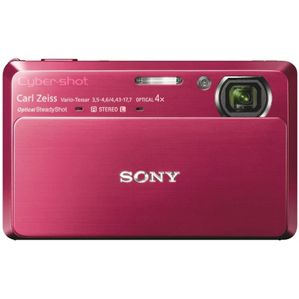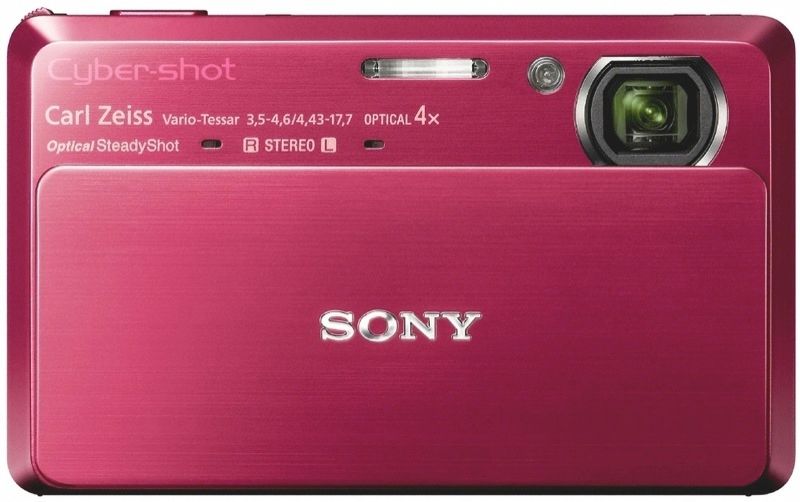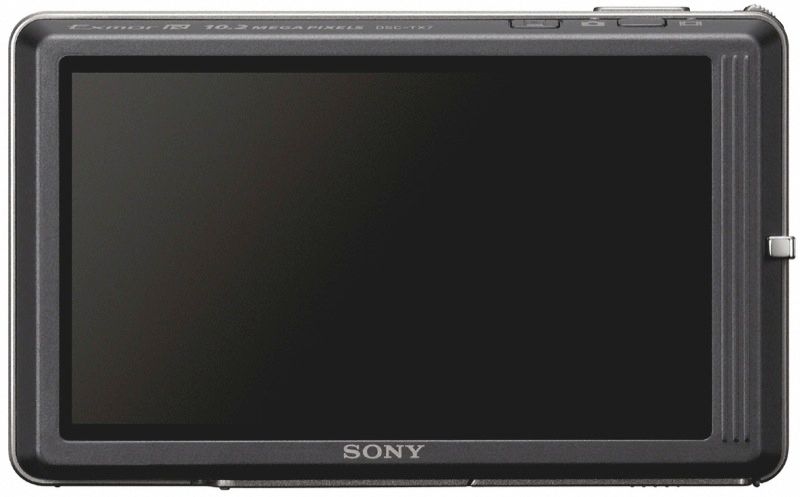Sony's new Cyber-shot, the TX7 has HD video, image stabilisation, a large, touch sensitive display and Sony's new Exmor R CMOS sensor boasting 10.2-megapixels. The neat design and great build are, perhaps, typically Sony, as is the price, but this little camera combines some advanced features with simplicity of use.
Our quick take
In short, the TX7 does what it does well; compact it certainly is, but within the limits that small size places on the design and handling; ditto the touchscreen and its (easily lost) stylus or "paint pen", so called as it is designed for use with the camera's accompanying paint software. However, we were left liking the TX7 for both its simplicity of use and the camera's "Why go into the menus? There's not much to control anyway" ethos. That and its natty Sweep and iAUTO modes as well as the impressive HD movie capture make it a nice little compact.
Overall, the Sony Cyber-shot DMC-TX7 acquits itself well. Low noise performance comes at the expense of detail, particularly at lower sensitivity settings such as ISO 125, which is a shame. And the lens' peripheral softness disappoints too, particularly in macro mode.
Still image quality is good enough for most general snaps though and the HD movies are very good for a camera of this ilk. Go back a little more than a year and HD at this level in a compact would have been almost unheard of.
Nevertheless, we cannot help but feel that RRP of almost £400 will make many baulk and they'll refuse at the last hurdle, that of opening their wallet or purse and paying for it.

Sony Cyber-shot DSC-TX7 camera - 4.0 / 5
| FOR | AGAINST |
|---|---|
|
|
The first thing you may notice about the TX7 has nothing to do with its large screen or natty design; it is probably the hefty £380 price tag. It's a price that puts it - very nearly - in the realm of a consumer oriented DSLR. And so while that may be a bitter pill to swallow, nevertheless there's (arguably) a reason for the price: the TX7 is crammed full of clever kit. And Sony resisted the temptation of cramming extra resolution on to the sensor it opted instead for a more than adequate 10.2-megapixel sensor of the new, Sony Exmor R CMOS variety.
Combined with an (internal) 25 to 100mm Carl Zeiss, 4x wide-zoom lens, this sensor and lens pairing works quite well, barring some slight peripheral softness and barrel distortion, captured detail is very good indeed though noise reduction processing does smooth detail a little more than we're happy with. In such cases, we'd rather have a little more detail at the expense of noise, or at the very least, be able to control the noise processing more. You cannot.
The camera lacks an optical viewfinder, as is common in many digital compacts today, thankfully the large 3.5-inch TruBlack touch screen is a gem; sharp, colourful and (just about) usable even in bright conditions, it quickly gets clogged up with finger marks and the supplied "paint pen" or stylus is a must for those with larger fingers for accurate control of the on-screen active button and menu options.
The camera's sleek design is certainly attractive (we had the very vivid red and very shiny version to test here) but like the display, it's is equally attractive to fingerprints, a minor niggle perhaps, but another issue we had was with the slide down cover on the camera's face. The slider is an on/off control and it's fiddly and will easily wreck a newly manicured fingernail in seconds, the lack of gripping surfaces is very obvious here.
Behind that cover sit the lens, a tiny and rather underpowered flash, an AF illuminator and stereo microphones for use when shooting HD movies, for example. The latter can be shot at up to 1080i resolution and movie quality is excellent in the AVCHD or MPEG4 formats. However, MPEG4 reduces movie resolution from 1920 x 1080 and 60 interlaced frames per second to 1440 x 1080, but still, with bit rates of up to 17mbps; it's on a par with last year's HD camcorders!
Viewing these movies and images on the camera's back you find the screen encompasses the entire rear camera surface (apart from the frame of the camera's bodywork) and as such means there's nowhere to hold on to without finger smears on the display, and I found my thumb would often inadvertently activate a setting or mode. The handling takes a bit of getting used to. But the TruBlack screen technology is the same as that found on Sony's laptops and is excellent.
The on-screen display of menus and controls is clever with options presented either as traditional menus, or as pop-outs that relate to the button pressed, such as flash or self timer settings.
Build is, as mentioned, very nice and the neat placement of the shutter and lens zooming control - the latter sits perched on the extreme corner of the camera - allow easy use even for someone with larger hands. However, the small movie/stills mode buttons and the playback button that nestle just behind the shutter release are fiddlier to use.
An additional on/of button, recessed for safety, is the final external control and here again, it's very hard to use, as it is so small. On the base is a docking port that allows you to connect the camera via the supplied dock to a PC or your TV (though there's no HDMI cable in the box) and makes things a bit neater when it's perched on your desk. A charger comes with the camera too so you can charge the Li-ion battery out of the camera. Battery life is excellent by the way, having lasted around 3 days on test without needing a boost.
Alongside the battery, which slots into a port underneath a flap on the camera's base, resides the SD/SDHC memory card or Sony's Memory Stick PRO Duo cards and there's 48MB of internal storage too. It's worth noting you'll need a high performance card for shooting HD movie clips lasting more than about minute (such as SanDisk's Extreme III cards, which were used here).
Some of that clever camera technology that has gone into making the TX7 pricey includes the Sweep Panorama setting. This allows you to take a panoramic image by moving the camera around as it records slices of the scene before it, stitching them all together as it goes. It works and is fun too, although we did manage to shoot one panorama with a dog in, giving the dog two heads – she moved towards the "sweep" as the shot was taken.
The panoramic shots are played back for you on the screen as a scrolling image, which is very fun and funky. Another plus is the iAuto setting that will assess the scene in front of the lens and pick a scene mode for you. Again, it seems to get things right most times and in portraits it can automatically bias metering and focusing to faces in the shot to flattering effect. All this automation takes the need to enter menus away and makes the camera very simple to use to boot.
Other features include the Handheld Twilight mode, where up to six images are combined into one, for reduced noise performance; akin to having built-in high dynamic range (HDR) ability and it works nicely enough, though a tripod and motionless subjects work best. The built-in image stabilisation is very good at mitigating a lot of the problems in lower light situations and Sony's BIONZ image engine works a treat throughout and along with the new Exmor sensor, makes the Sweep and other funky stuff possible too. Oh and you get 12-scene modes to select manually if you wish as well should the camera not get things right first time.
BIONZ also allows Sony to throw in up to 10fps action shooting and an Anti Motion Blur mode (essentially an automatic high sensitivity mode) and the camera is pretty much as replete with kit as you can possibly cram into its tiny 133g frame.
Close inspection of images reveals slight edge softness to wider view images and these are also affected by some barrel distortion and chromatic aberration, typical of this sort of compact if not at this price point. However, colour is well rendered and that's good as there's no way to adjust colour settings, which is quite unusual in such compacts. Nevertheless, white balance control is good, though control of image quality is missing so you're left with what the camera provides. Metering is very good overall but we found it biased slightly to overexpose.
The nine-zone auto focusing system is fast and pretty accurate, particularly on faces in a shot, while macro focusing - down to a reasonable 8cm - is just about okay, since while the central area of the macro image is sharp, that aforementioned softness around the edges becomes very noticeable.
To recap
Sleek and small, the Sony Cyber-shot TX7 has a nice active display and good build. The slide down front cover is a bit fiddly and the on-screen controls are small, requiring use of the supplied stylus, which could easily get lost. However, image quality is good, noise is kept under control - mostly - and the HD video and Sweep Panorama settings are a joy. Pricey it may be and a bit of mixed bag overall, but it's still worth a look




